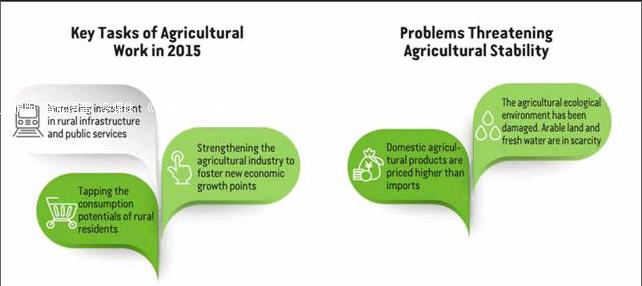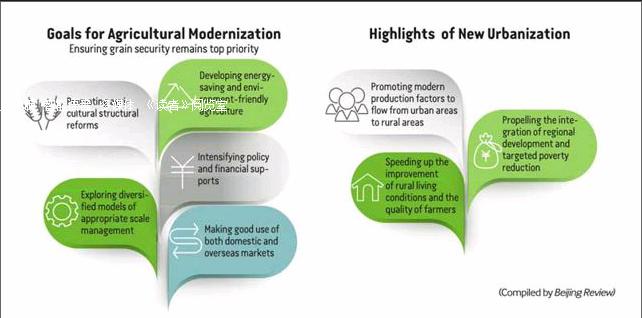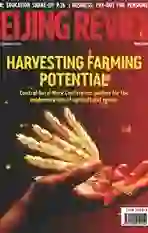MODERNIZING AGRICULTURE
2015-01-29ByDengYaqing
By+Deng+Yaqing


Sun Xiaowei, a young villager who owns 90 mu (6 hectares) of field in Wangwudao Village, Liaoyang County of Liaoning Province, saw his income soaring last year. “I transferred the management right of my land to a rural cooperative. In return, it pays me 750 yuan ($120) per mu every year,” said Sun, who now also serves as a technician in the cooperative, reveling in the fact that his annual income almost doubled in 2014.
Land right transfer and scale management were among the key issues discussed at the 2014 Central Rural Work Conference concluded on December 23, which mapped out the plan for 2015. Centered on the transformation and modernization of agricultural development, the conference also tapped into preservation of local culture and ecological environment and infrastructure construction in rural areas.
“Compared with the rapidly advancing urbanization, industrialization and informatization, Chinas agricultural modernization is relatively stagnant,” said Li Guoxiang, a researcher with the Institute of Rural Development under the Chinese Academy of Social Sciences.
Lis argument is echoed by Zheng Fengtian, a professor from the Department of Agriculture and Rural Development at the Renmin University of China, who believes agricultural modernization is a critical variable that significantly affects the progress of industrialization and urbanization. “If agricultural modernization goes on smoothly, more labor force will be freed from farm work to push forward urbanization,” said Zheng.
Agricultural challenges
Although Chinas grain output and rural residents income have realized consecutive growth for 11 years, agriculture still faces mounting risks and structural problems.
According to statistics provided by Li Wei, President of Development Research Center of the State Council, from 2004 to 2012, the land cost, labor cost and service charge of growing rice, wheat and corn increased respectively by 15.7 percent, 10.4 percent and 8.7 percent, higher than the price growth of the three types of staple grain.
“While agricultural production costs keep climbing domestically, the prices for bulk agricultural commodities are sliding down in the international market. As a result, agricultural import is on the increase,” said Minister of Agriculture Han Changfu.
For one thing, China faces a lack of agricultural resources, with its per-capita cultivated land and water only equivalent to one third and one fourth of the world average respectively; for another, its agricultural production heavily depends on the pesticide and chemical fertilizer, which has resulted in declining land capacity and food security risks. A large part of Chinas agricultural production capacity was achieved at the expense of ecological environment, said Li Wei.
Nevertheless, the imbalance of agricultural production also grows more and more evident. Because of irrational regional layout and different resource advantages, north-to-south grain transportation is concurrent with the southto-north water diversion. While stocks of some types of agricultural products pile up, others have to be imported from the overseas market. In addition, as the consumption of chemical fertilizer keeps increasing and land capacity keeps declining, animal waste has not yet been efficiently applied in farming.
“Chinas agricultural production is now strained by rising costs and decreasing financial subsidies. Its squeezed by deteriorating environment and resource scarcity. If these problems fail to be solved in days to come, they will undermine the sustainable agricultural development,” said Li Wei.
So how can China surmount these obstacles? Zhu Lizhi, a researcher with the Institute of Agricultural Economics and Development under the Chinese Academy of Agricultural Sciences, believes the answer lies in agricultural modernization. “By speeding up the transformation of agricultural development model, Chinas agricultural industry will shake off heavy dependence on resource consumption and the sacrifice of ecological environment, and shift its focus to quality and efficiency,” said Zhu.
Scale management
In November 2014, the State Council released the Opinions on Guiding the Orderly Transfers of Management Rights of Rural Land and Promoting Moderate Scale Management, proposing to separate the ownership, contracting and management of rural land.
“Now, a rural household owns no more than half a hectare on average, and such a pattern of small-scale management has severely dragged down efficiency,” said Han, suggesting that a diversity of moderate scale management should be applied to boost the orderly transfers of management rights of rural land, especially toward people skilled at farming, and that ef- forts should be made to foster new agricultural entities such as large-scale grain growers, family farms and cooperatives.
Bian Quanshui, an agricultural analyst with China International Capital Corp. Ltd., also agrees that moderate scale management is an inevitable stage leading to agricultural modernization.
“Compared with developed countries, China now lags far behind in terms of agricultural productivity and mechanization, partly because land management is carried out in a loose and dispersed way,” said Bian, who holds developing moderate scale management will give full play to the economies of scale, elevate labor productivity and liberalize more labor for the manufacturing and service industries.
Beyond that, a consensus was reached at the conference to introduce modern industrial organization models such as industry chain and value chain into the agricultural sector, in order to facilitate the integration of the agricultural, manufacturing and service industries. In other words, it means expanding the agricultural industry from simple grain production to include the processing and circulation of agricultural products and the leisure industry, prolonging the industry chain in an effort to boost added value and farmers income.
Rural people valued
In the past, the construction of new countryside paid far more attention to infrastructure and living conditions than local culture and ecological civilization. As the flooding out of rural labor force leaves behind more and more “hollow villages” and unattended women, seniors and children, the conception of the “peoples new countryside” was put forward, representing that the Chinese Government has set higher requirements for the construction of new rural area.
Cheng Guoqiang, a research fellow with the Development Research Center of the State Council, argued that “peoples new countryside” should be put into reality in three ways. First, a service system should be established to take care of seniors, women and children who have been left behind. The system should also improve public services such as education and medical treatment. Second, local folk culture needs to be preserved, preventing rural areas from becoming deserted villages or villages of left-behind groups. Third, the protection and improvement of ecological environment need to be intensified in rural areas.
In the past, agricultural modernization focused more on simple mechanization, said Liu Xiaochuan, a professor from the School of Public Economics and Administration of Shanghai University of Finance and Economics.“The modernization of rural people now receives equal attention,” said Liu. Though rural income and regional economy have experienced rapid growth in some areas, people dont see their living conditions improved, because the development of basic public infrastructure still lags behind.
Liu said its not a simple process of urbanization or just increasing farmers income; rather, its letting urban areas support rural areas to quicken the steps of agricultural modernization.“More importantly, rural public services including medical treatment, education, physical activities and healthcare can make improvements in the process,” he said.
Agricultural modernization also deals with the training of farmers technological quality and the efficient utilization of agricultural capital, said Zhang Zhenghe, a professor from the School of Economics and Management at the China Agricultural University.
Since people engaged in the agricultural industry are universally at a lower level of technological quality, advanced agricultural development modes must first be set up through technological demonstration areas, said Zhang.
“When agriculture becomes a high-value industry, the quality of operators has to be improved to conduct capital operation and carry out technological innovation. In this way, they will become new agricultural operating entities,”said Zhang.
